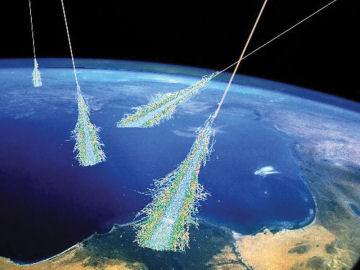High-Energy Discovery
Scientists have traced the most energetic particles in the universe to their source: giant black holes.
By Emily Sohn
You may have a lot of energy sometimes—after eating some candy, for example. But the energy you have in your most hyper moments pales in comparison to the energy packed in ultra-high-energy cosmic rays.
Cosmic rays are particles that travel from space into Earth’s atmosphere. Ultra-high-energy cosmic rays are tiny, very rare particles that contain extremely large amounts of energy. These rays have more energy than any other known particles in the universe.
 |
|
This illustration shows the shower of particles produced when Earth’s atmosphere is struck by ultra-high-energy cosmic rays (the most energetic particles known in the universe). |
| Simon Swordy/University of Chicago, NASA |
For decades, scientists have speculated about where ultra-high-energy cosmic rays come from. Now, an international team of researchers has found the first solid evidence that these energetic particles come from supermassive black holes in galaxies near ours.
“This is a landmark finding,” says Paul Mantsch of the Fermi National Accelerator Laboratory in Batavia, Ill. Along with scientists from 17 countries, he helped make the discovery at the Pierre Auger Observatory in Argentina.
For the new study, the observatory recorded 27 ultra-high-energy cosmic rays. Results showed that 20 of those particles came from points in the sky where galaxies that contain massive black holes are already known to be. The link is too strong to be a coincidence, the researchers say.
The researchers suggest that the cosmic rays are coming from extrabright areas at the centers of galaxies. Each such area is known as an active galactic nucleus (called AGN). All the AGNs identified in the new study lie fairly close to the Milky Way. None is more than 326 million light-years away.
How do AGNs produce such high-energy particles? For one thing, black holes inside AGNs feed on swirling disks of gas and dust. As the material spirals in, it heats up and spits out radiation with lots of energy.
Also, AGNs typically spit out huge jets of high-speed gas. These jets might blast some cosmic rays to extraordinarily high energies, the researchers say.
The Auger observatory, which opened in 2004, is enormous—and it has to be. It works by detecting the particles created when cosmic rays smack into Earth’s upper atmosphere. These secondary particles fall to Earth in a wide shower that can spread out over 40 square kilometers (15 square miles) by the time they reach Earth.
And the particles are hard to catch. One square kilometer (less than half a square mile) of Earth’s upper atmosphere gets hit by ultra-high-energy cosmic rays just once every 100 years or so. To detect as many of the particles as possible, the observatory sprawls out over 3,000 km2 (1,160 miles2).
The exciting new discovery has some scientists convinced that it’s time to build a second facility just like the Auger, which is in the Southern Hemisphere. To catch as many particles as possible, they say, the new observatory should be built in the Northern Hemisphere.—Emily Sohn
Going Deeper:
Cowen, Ron. 2007. Ray tracing: Energetic cosmic rays linked to giant black holes. Science News 172(Nov. 10):291-292. Available at http://www.sciencenews.org/articles/20071110/fob2.asp .
For more information about ultra-high-energy cosmic rays and the Pierre Auger Observatory, go to www.auger.org/ (Pierre Auger Cosmic Ray Observatory).







